Soumyajit Mandal
Instrumentation Department, Brookhaven National Laboratory, Upton, NY
General Framework for Array Noise Analysis and Noise Performance of a Two-Element Interferometer With a Mutual-Coupling Canceler
Apr 01, 2025Abstract:This article investigates the noise performance of a two-element phased array and interferometer containing a recently introduced self-interference canceler, which in the context of this work acts as a mutual-coupling canceler. To this end, a general framework is proposed to permit noise analysis of this network and a large variety of other networks. The framework-based numerical analysis for a two-element-phased array shows that the addition of the canceler significantly increases the beam-equivalent noise temperature. For a two-element interferometer used in cosmology, this increase in noise temperature is still acceptable as the sky noise temperature in the 20-to-200 MHz band is high. When used in an interferometer, the canceler provides the ability to null mutual coherence at the interferometer output. The ability to provide matching to reduce the sensitivity of the null in mutual coherence to the phase of the 90deg hybrids in the canceler is discussed.
An Integer-N Frequency Synthesizer for Flexible On-Chip Clock Generation
Nov 03, 2024



Abstract:A low-power integer-N frequency synthesizer for flexible on-chip clock generation has been designed in 65 nm CMOS technology. The circuit can be programmed to generate two independent low-jitter clocks between 30 MHz and 3 GHz that are locked a 10-50 MHz reference input. The design uses a phase-locked loop (PLL) with a dual-tuned LC voltage-controlled oscillator (VCO), programmable feedback divider, and dual output dividers. The total power consumption from 1.2 V and 0.8 V supplies is 4.0 mW. Experimental results confirm the functionality of the proposed synthesizer over a wide range of output frequencies.
Automated and Holistic Co-design of Neural Networks and ASICs for Enabling In-Pixel Intelligence
Jul 18, 2024Abstract:Extreme edge-AI systems, such as those in readout ASICs for radiation detection, must operate under stringent hardware constraints such as micron-level dimensions, sub-milliwatt power, and nanosecond-scale speed while providing clear accuracy advantages over traditional architectures. Finding ideal solutions means identifying optimal AI and ASIC design choices from a design space that has explosively expanded during the merger of these domains, creating non-trivial couplings which together act upon a small set of solutions as constraints tighten. It is impractical, if not impossible, to manually determine ideal choices among possibilities that easily exceed billions even in small-size problems. Existing methods to bridge this gap have leveraged theoretical understanding of hardware to f architecture search. However, the assumptions made in computing such theoretical metrics are too idealized to provide sufficient guidance during the difficult search for a practical implementation. Meanwhile, theoretical estimates for many other crucial metrics (like delay) do not even exist and are similarly variable, dependent on parameters of the process design kit (PDK). To address these challenges, we present a study that employs intelligent search using multi-objective Bayesian optimization, integrating both neural network search and ASIC synthesis in the loop. This approach provides reliable feedback on the collective impact of all cross-domain design choices. We showcase the effectiveness of our approach by finding several Pareto-optimal design choices for effective and efficient neural networks that perform real-time feature extraction from input pulses within the individual pixels of a readout ASIC.
Fusion Intelligence: Confluence of Natural and Artificial Intelligence for Enhanced Problem-Solving Efficiency
May 16, 2024Abstract:This paper introduces Fusion Intelligence (FI), a bio-inspired intelligent system, where the innate sensing, intelligence and unique actuation abilities of biological organisms such as bees and ants are integrated with the computational power of Artificial Intelligence (AI). This interdisciplinary field seeks to create systems that are not only smart but also adaptive and responsive in ways that mimic the nature. As FI evolves, it holds the promise of revolutionizing the way we approach complex problems, leveraging the best of both biological and digital worlds to create solutions that are more effective, sustainable, and harmonious with the environment. We demonstrate FI's potential to enhance agricultural IoT system performance through a simulated case study on improving insect pollination efficacy (entomophily).
Radars for Autonomous Driving: A Review of Deep Learning Methods and Challenges
Jun 17, 2023



Abstract:Radar is a key component of the suite of perception sensors used for safe and reliable navigation of autonomous vehicles. Its unique capabilities include high-resolution velocity imaging, detection of agents in occlusion and over long ranges, and robust performance in adverse weather conditions. However, the usage of radar data presents some challenges: it is characterized by low resolution, sparsity, clutter, high uncertainty, and lack of good datasets. These challenges have limited radar deep learning research. As a result, current radar models are often influenced by lidar and vision models, which are focused on optical features that are relatively weak in radar data, thus resulting in under-utilization of radar's capabilities and diminishing its contribution to autonomous perception. This review seeks to encourage further deep learning research on autonomous radar data by 1) identifying key research themes, and 2) offering a comprehensive overview of current opportunities and challenges in the field. Topics covered include early and late fusion, occupancy flow estimation, uncertainty modeling, and multipath detection. The paper also discusses radar fundamentals and data representation, presents a curated list of recent radar datasets, and reviews state-of-the-art lidar and vision models relevant for radar research. For a summary of the paper and more results, visit the website: autonomous-radars.github.io.
Towards a Low-SWaP 1024-beam Digital Array: A 32-beam Sub-system at 5.8 GHz
Jul 19, 2022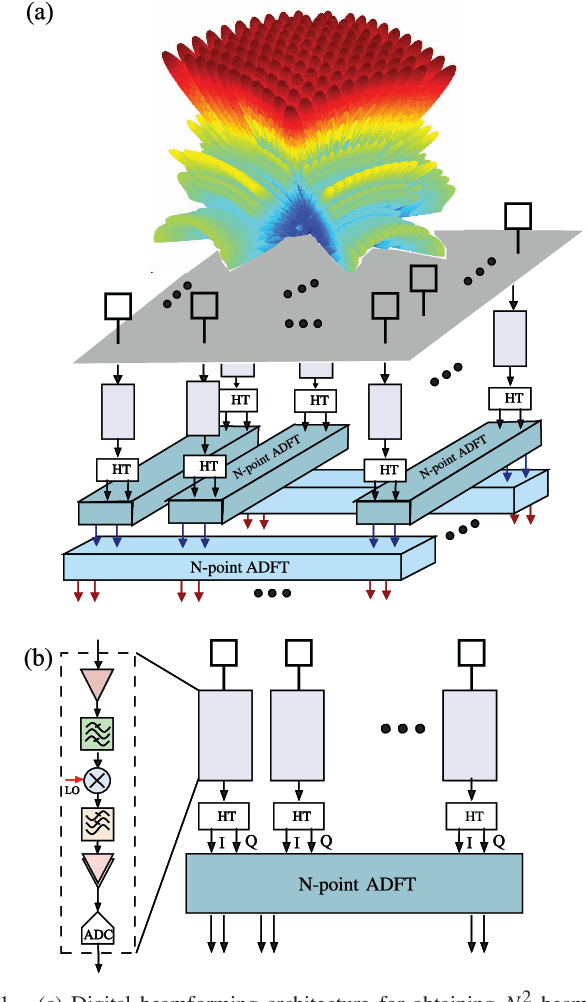

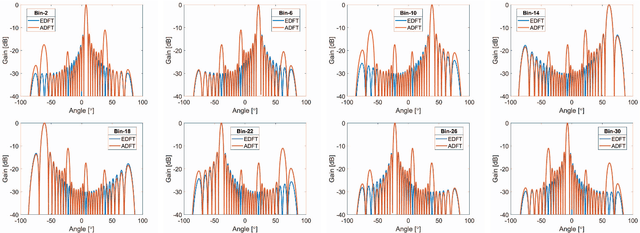

Abstract:Millimeter wave communications require multibeam beamforming in order to utilize wireless channels that suffer from obstructions, path loss, and multi-path effects. Digital multibeam beamforming has maximum degrees of freedom compared to analog phased arrays. However, circuit complexity and power consumption are important constraints for digital multibeam systems. A low-complexity digital computing architecture is proposed for a multiplication-free 32-point linear transform that approximates multiple simultaneous RF beams similar to a discrete Fourier transform (DFT). Arithmetic complexity due to multiplication is reduced from the FFT complexity of $\mathcal{O}(N\: \log N)$ for DFT realizations, down to zero, thus yielding a 46% and 55% reduction in chip area and dynamic power consumption, respectively, for the $N=32$ case considered. The paper describes the proposed 32-point DFT approximation targeting a 1024-beams using a 2D array, and shows the multiplierless approximation and its mapping to a 32-beam sub-system consisting of 5.8 GHz antennas that can be used for generating 1024 digital beams without multiplications. Real-time beam computation is achieved using a Xilinx FPGA at 120 MHz bandwidth per beam. Theoretical beam performance is compared with measured RF patterns from both a fixed-point FFT as well as the proposed multiplier-free algorithm and are in good agreement.
* 19 pages, 8 figures, 4 tables. This version corrects a typo in the matrix equations from Section 3
A CMOS SoC for Wireless Ultrasonic Power/Data Transfer and SHM Measurements on Structures
Oct 24, 2021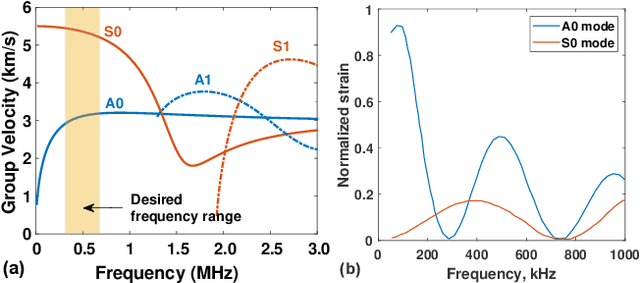

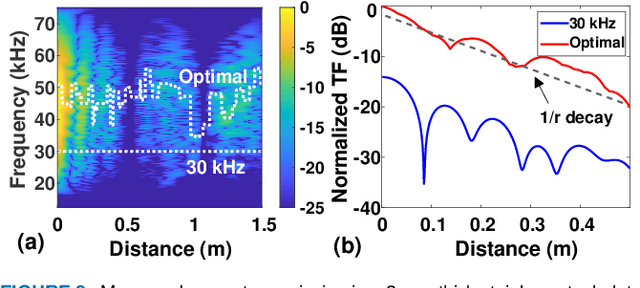
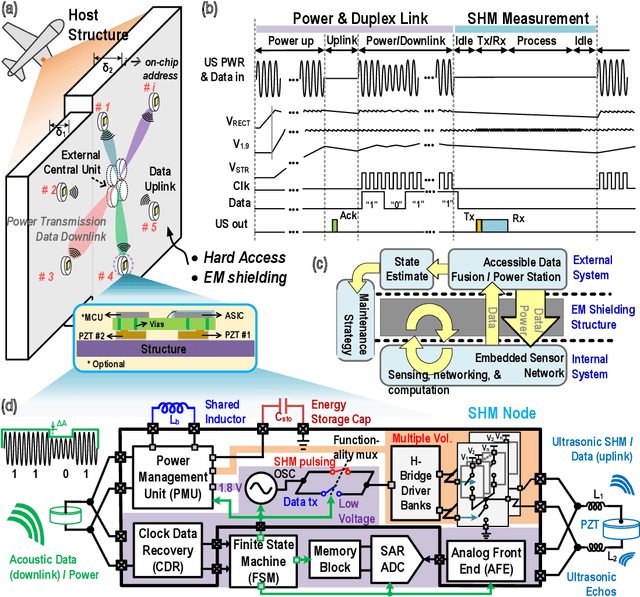
Abstract:This paper describes a highly-integrated CMOS system-on-chip (SoC) for active structural health monitoring (SHM). The chip integrates ultrasonic power and bidirectional half-duplex data transfer, a power management unit (PMU), and an ultrasound transceiver to enable wireless ultrasonically-coupled sensor SHM networks on structures. The PMU includes an active bias-flip rectifier with off-delay compensation, high-efficiency dual-path DC-DC converter with inductor time-sharing, and five switched-capacitor DC-DC converters to generate multi-level spectrally band-limited pulses for guided-wave SHM. The chip was fabricated in a standard 180 nm process and has a die area of $2\times 2$ mm$^{2}$. Test results show power conversion efficiency (PCE) $>85\%$ for the active rectifier, $>70$\% for the inductive DC-DC converter, and $>60$\% for the switched-capacitor DC-DC converters. Output pulses have a peak-to-sidelobe ratio (PSL) $>30$~dB and worst-case out-of-band emissions $<-30$~dB, respectively. The SoC was integrated with a low-power microcontroller and passive components to realize miniaturized (15~mm $\times$ 30~mm) wireless SHM nodes. A set of nodes was deployed on an SHM test-bed (carbon fiber reinforced polymer sheet) representing an airframe panel. Tests on this wireless network confirm both long-range ultrasound power/data transfer and the ability to detect structural damage.
High-Sensitivity Electric Potential Sensors for Non-Contact Monitoring of Physiological Signals
Oct 23, 2021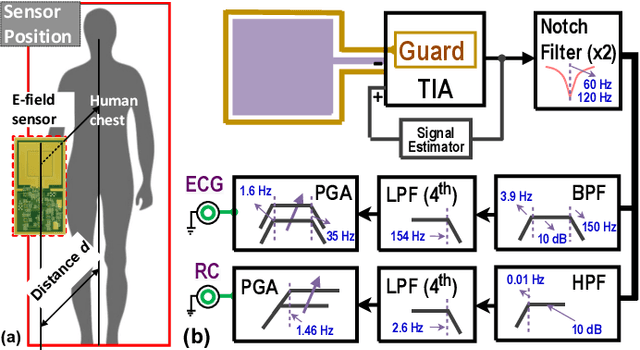



Abstract:The paper describes highly-sensitive passive electric potential sensors (EPS) for non-contact detection of multiple biophysical signals, including electrocardiogram (ECG), respiration cycle (RC), and electroencephalogram (EEG). The proposed EPS uses an optimized transimpedance amplifier (TIA), a single guarded sensing electrode, and an adaptive cancellation loop (ACL) to maximize sensitivity (DC transimpedance $=150$~G$\Omega$) in the presence of power line interference (PLI) and motion artifacts. Tests were performed on healthy adult volunteers in noisy and unshielded indoor environments. Useful sensing ranges for ECG, RC, and EEG measurements, as validated against reference contact sensors, were observed to be approximately 50~cm, 100~cm, and 5~cm, respectively. ECG and RC signals were also successfully measured through wooden tables for subjects in sleep-like postures. The EPS were integrated with a wireless microcontroller to realize wireless sensor nodes capable of streaming acquired data to a remote base station in real-time.
A High-Dynamic-Range Digital RF-Over-Fiber Link for MRI Receive Coils Using Delta-Sigma Modulation
May 27, 2021

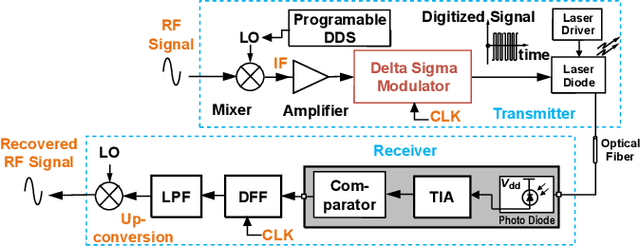
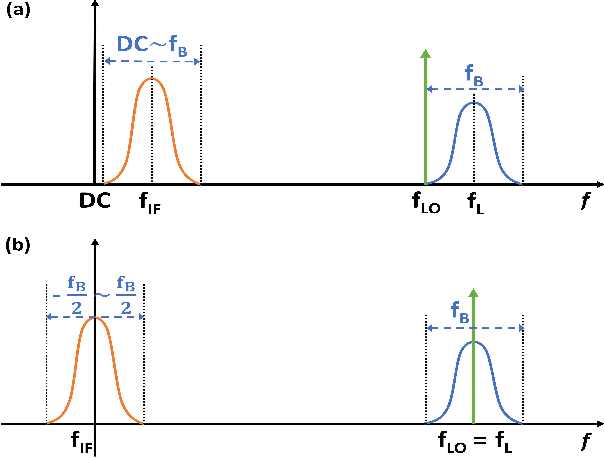
Abstract:The coaxial cables commonly used to connect RF coil arrays with the control console of an MRI scanner are susceptible to electromagnetic coupling. As the number of RF channel increases, such coupling could result in severe heating and pose a safety concern. Non-conductive transmission solutions based on fiber-optic cables are considered to be one of the alternatives, but are limited by the high dynamic range ($>80$~dB) of typical MRI signals. A new digital fiber-optic transmission system based on delta-sigma modulation (DSM) is developed to address this problem. A DSM-based optical link is prototyped using off-the-shelf components and bench-tested at different signal oversampling rates (OSR). An end-to-end dynamic range (DR) of 81~dB, which is sufficient for typical MRI signals, is obtained over a bandwidth of 200~kHz, which corresponds to $OSR=50$. A fully-integrated custom fourth-order continuous-time DSM (CT-DSM) is designed in 180~nm CMOS technology to enable transmission of full-bandwidth MRI signals (up to 1~MHz) with adequate DR. Initial electrical test results from this custom chip are also presented.
 Add to Chrome
Add to Chrome Add to Firefox
Add to Firefox Add to Edge
Add to Edge